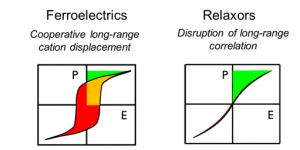| Technical objectives: | • Lead-free perovskite multilayer thin-film capacitor • Energy density: > 50 J/cm3 • Full-capacitor charge: > 0.6 mJ (at 4 V input voltage) |
The stored energy density is the integral of electric polarisation vs. applied electric field, and in perovskite materials corresponds to the area of the polarisation hysteresis curve. BaTiO3 ferroelectrics possess high power density due to fast charge reorientation processes, however have low energy density due to elastic energy consumption by ferroelectric domain switching, which leads to a square hysteresis loop.

To increase recoverable energy density (i.e. upon capacitor discharge), ferroelectric long-range order needs to be broken by chemical substitution, so that polar domains are present only on the nanoscale. This produces a slim hysteresis loop, specifically in relaxor (highly doped) systems. Compositions at the crossover between ferroelectric and relaxor help maintaining high relative permittivity (also needed for high energy density) and so are the best compromise.
Doping will be performed at the A- and/or B-site of the perovskite. Homo- and heterovalent substituents induce ferroelectric long-range order disruption by different mechanisms, so that multiple degrees of freedom are available for compositional tuning. Using thin film deposition, moreover, allows reducing defects in the lattice and thereby further increases the energy density.
In FOXES we will develop the technology to produce multilayer capacitors and to integrate them in the Power Cube. The target is to realise a 2 x 2 cm2 capacitor with two layers providing at least 0.6 mJ stored energy by the ~4 V input voltage provided by the PSCs.
